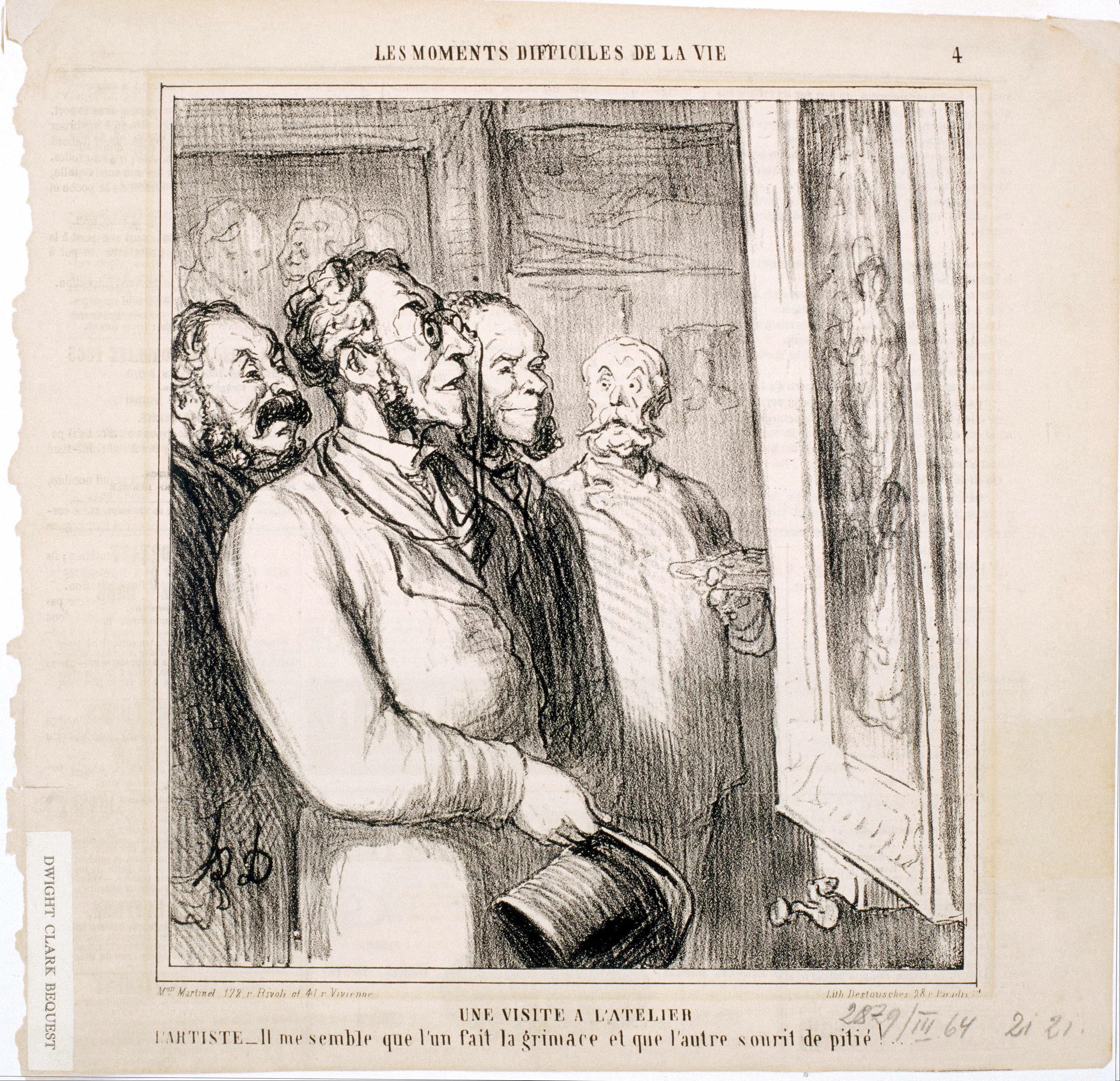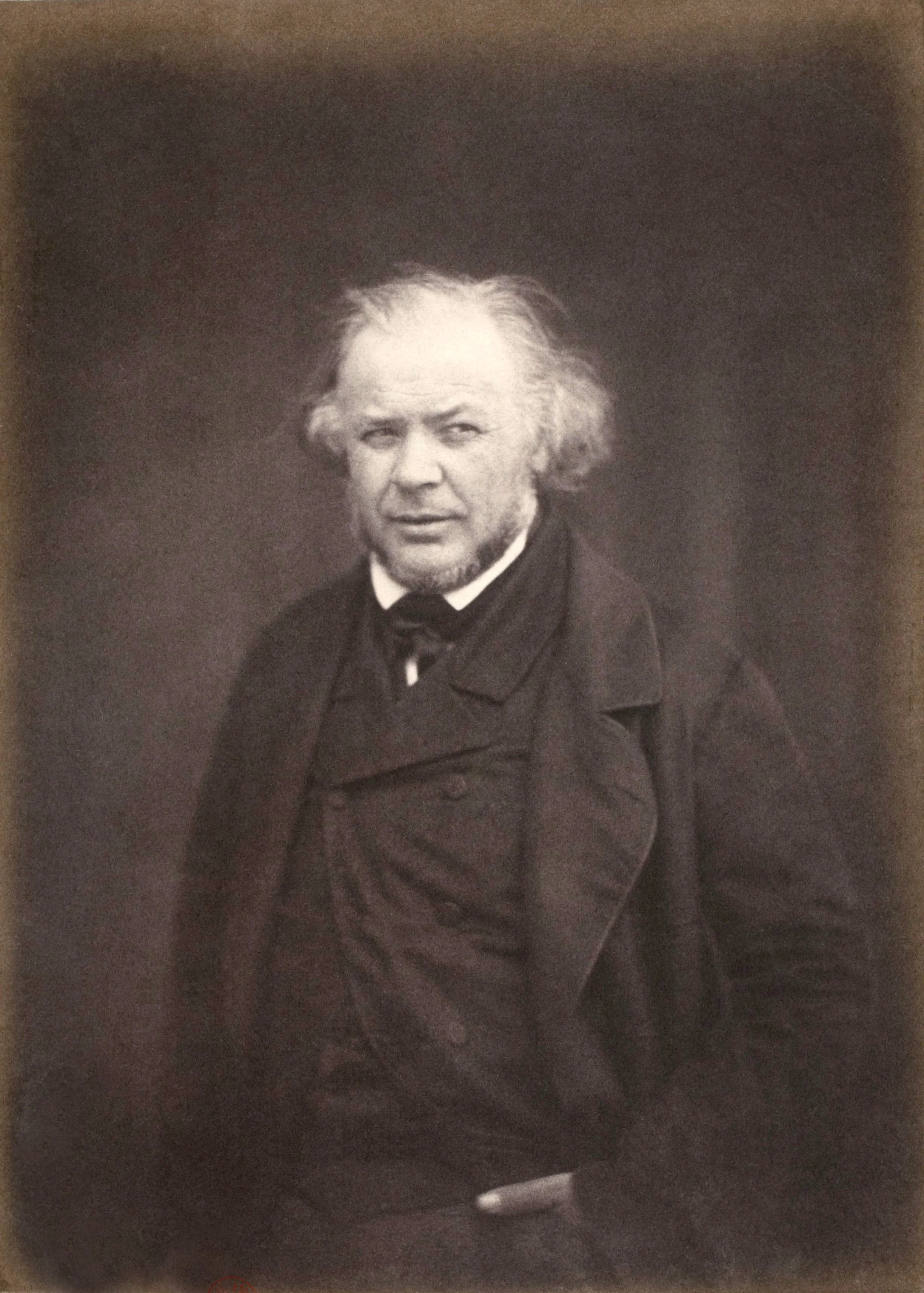During the 1850's Honoré Daumier was struggling to keep up his own interest in caricatures and lithographs. He was more excited about painting, but could not make a living doing what he loved. This lack of interest along with changing tastes lead his print work to become less popular with the public and with publishers. In 1860 his contract with Le Charivari was allowed to lapse. The artist spent his time painting and contributed lithographs to other publications. In 1863 it became necessary for the Daumier's to move from Île Saint-Louis due to reduced income. He was rehired by Le Charivari around the end of the year.
Daumier's Marketable Skill Less Popular, but Still the Only Income
1864 - Les Moments Difficiles De La Vie (alt) (The Difficult Moments Of Life) is a series of seven plates published in Le Charivari showing people in difficult and uncomfortable situations.
1864 - Croquis pris au salon (alt1) (alt2) (Salon Sketches) is a series of ten lithographs published in Le Charivari between 1864 and 1865. It includes outstanding character sketches portraying various aspects of the yearly art exhibitions in Paris.
All this work required that the artist draw his caricatures in reverse on lithographic stone or wood engraving blocks. Then the work was handed off to the next stage in production. There is an excellent article on Daumier by Carolyn Peter, director of the Laband Art Gallery at Loyola Marymount University (as of 2013), that contains a detailed description of the collaborative process involved in producing the comic newspaper.
Elisabeth Luther Cary describes Daumier's style in his lithographs:
"… one perceives a steady growth of the quality least often found in connection with a monumental style - the sense of movement. In all the later lithographs nothing is more salient than this. The energy of motion is in every line of the men and women and children, of the dogs and cats and horses, nothing is fixed or posed, everything is ready to shift and change as in a Japanese drawing of the Ukiyo-ye school." - page 33
Henry James also referenced another often repeated fact from an early biography of Daumier by M. Grand Carteret from Les Mœuis et la Caricature en France published in 1888.
"...that our artist produced nearly four thousand lithographs and a thousand drawings on wood, up to the time when failure of eyesight compelled him to rest." - page 406 Century Illustrated
The Paris Commune and One Last Blast of Caricature
Following the Franco-Prussian War of 1870, where the Second French Empire under Napoleon III was defeated by Prussian industrial might, a Third Republic was declared and the French resistance kept up the fight. Paris fell on January 28, 1871. The Paris Commune or the Fourth French Revolution took power in Paris for 73 days beginning March 18, 1871 and ending May 28, 1871. These conditions led to a flurry of caricatures and cartoons.
In The American Magazine of Art of March 1919 an unsigned article appears titled “War and caricature”. This quote from the article addresses caricature during the Paris Commune.
"In France, the tragic days of the siege and the Commune saw the relaxation of the former strict censorship of the press and a resulting veritable inundation of cartoons. Under the leadership of Daumier, the small group of artists who infused their genius into the weekly pages of Charivari made these tragic months one of the famous periods in the annals of French caricature. There were Cham, Andre Gill, Hadel, De Bertall, De Pilopel, Faustin, Draner, and a number of others not so well known. But above all it was Daumier who after twenty years of the Empire during which his pen had been politically idle returned in his old age to the fray with all the vigor of the best days of La Caricature." - page 185
Daumier's last illustration for Le Charivari was published on December 18, 1875. It is titled “Les Pères Conscrits” (The Conscript Fathers) and is plate number 282 in the Actualités series. The image shows three bourgeois gentlemen returning to the Senate.
The Final Days of Daumier
In the late 1870's Daumier's eyesight became so bad he was almost blind. This resulted in his inability to work and subsequent poverty. He owned a home in Valmondois where he lived with his wife from 1874. The bad financial situation led to the home being foreclosed on. Fortunately the painter Jean-Baptiste-Camille Corot paid the mortgage as a gift to his friend.
Champfleury published a short biography of Daumier's life and work as part of Histoire e la Caricature Moderne (History of Modern Caricature) first published in 1865. Champfleury wrote a brief bio of Daumier that appeared in L'Art in 1878. This was expanded into a more extensive version of Daumier's life story in the Exposition des peintures et dessins de H. Daumier (Exhibition of paintings and drawings by H. Daumier). This was a catalog for gallery showing of he work held at Galeries Durand-Ruel by Durand-Ruel et fils. The catalog was published in 1878.
The artist's friends convinced gallery owner Paul Durand-Ruel to put on an exhibition of Daumier's paintings. Victor Hugo was Daumier's patron in this endeavor. Sadly, the event was not successful and the great caricaturist did not live to receive the accolades he had long sought for his painting.
M. Eugène Montrosier also wrote an article praising Daumier in L'Art in 1878. Henry Miller, in an article about Daumier published in The Century Illustrated, Volume 39 in 1890 quotes Montrosier:
"M. Eugene Montrosier says of it (“Saltimbanques” or “Acrobats”) that "The drawing is masterly, incomparably firm; the composition superb; the general impression quite of the first order. It exhibits a pair of lean, hungry mountebanks, a clown and a harlequin beating the drum and trying a comic attitude, to attract the crowd at a fair, to a poor booth in front of which a painted canvas, offering to view a simpering fat woman, is suspended. But the crowd does not come, and the battered tumblers, with their furrowed cheeks, go through their pranks in the void. The whole thing is symbolic and full of grimness, imagination, and pity. It is the sense that we shall find in him, mixed with his homelier extravagances, an element prolific in indications of this order that draws us back to Daumier." - page 413 Century Illustrated
Honoré Daumier died of a stroke 15 days shy of his 71st birthday on February 10, 1879. He did not live a particularly long life, but it was an extraordinary time to live. He had witnessed and documented war, the fall of the French monarchy, political revolution, cultural revolution, the start of the industrial revolution, and the move away from an agrarian society. His art is still communicating with readers today as people rediscover his work online.
The next post in this series will include some quotes about Honoré Daumier and a list of resources about the great caricature artist.
NEXT - Honoré Daumier Part 5


